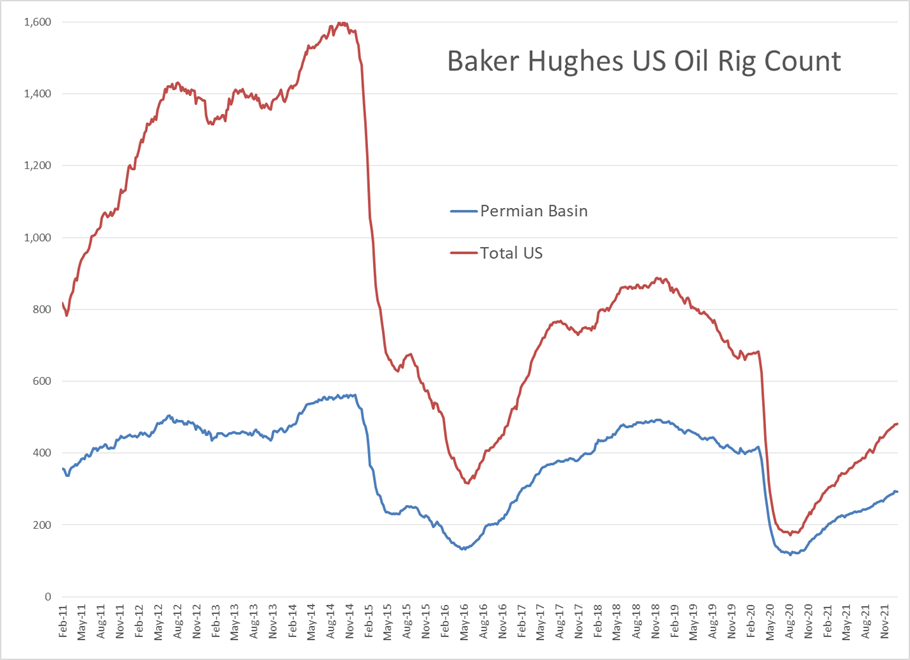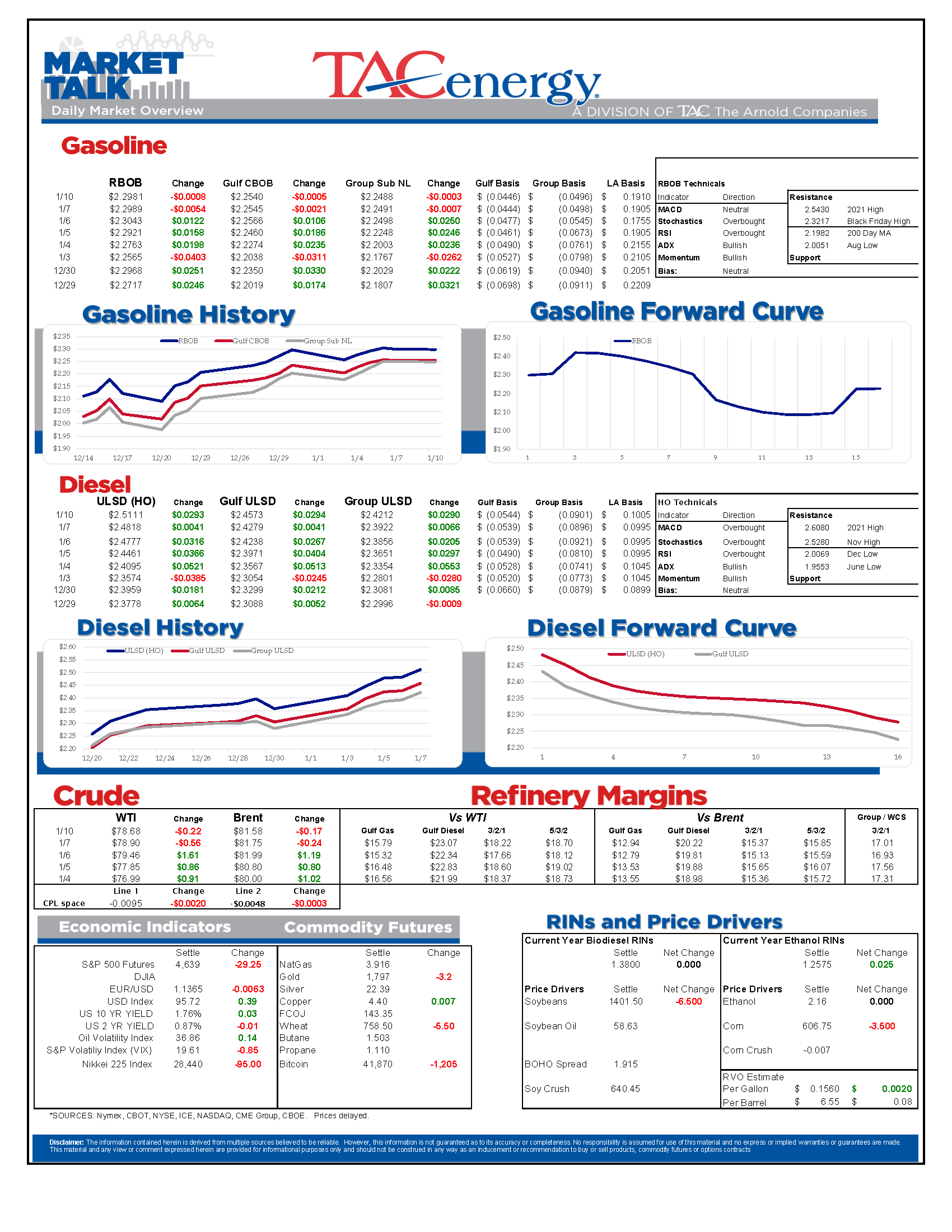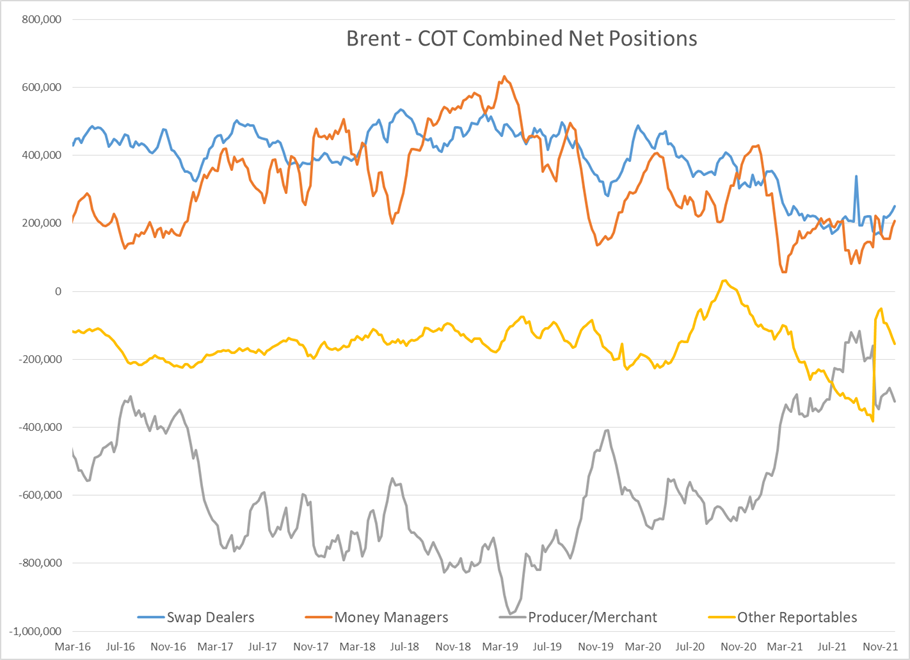Diesel Prices Attempting A Rally, While Gasoline And Crude Prices Are Moving Modestly Lower

It’s a mixed bag for energy markets to start the week with diesel prices attempting a rally, while gasoline and crude prices are moving modestly lower. There appears to be a bit of a technical tug-of-war happening at the moment after last week’s strong rally that quickly took out the near term targets on the charts.
There’s a similar fundamental dichotomy as disruptions to global oil exports give the bulls reason to cheer, while Omicron continues to shake up the demand outlook near term. In the US there’s a mismatch between a dramatic drop in demand over the past couple of weeks, offset by a rash of refinery problems, mainly focused on the gulf coast, and PNW markets. On the demand side, the recent rally seems to suggest that both the global impact from Omicron, and the US slowdown are seen as temporary issues, and on the supply side we will just have to wait and see how long they might last.
Money Managers are piling back into the energy arena, with a 2nd straight week of heavy increases to net length held by money managers in refined products. WTI was the only exception this week with a modest decrease, and RBOB was perhaps the most noteworthy as its speculative length reached the highest level in almost a year suggesting the hedge funds really don’t care about, or aren’t aware of, the winter doldrums for gasoline demand.
Baker Hughes reported a net increase of 1 active oil rig working in the US last week, with the gains coming in Louisiana and Colorado, while Texas saw a decline of 3 rigs. A Reuters article last week highlighted a new challenge for producers in Texas that may have to curb production because they don’t have a way to dispose of their waste water without causing earthquakes. Add that to the list of reasons why the recovery in US drilling is much slower vs the past two boom/bust cycles along with supply bottlenecks, labor shortages and more hesitant financing.
Click here to download a PDF of today's TACenergy Market Talk.
Latest Posts
Week 17 - US DOE Inventory Recap
The Energy Complex Is Trading Modestly Lower So Far This Morning With WTI Crude Oil Futures Leading The Way
Energy Futures Are Drifting Quietly Higher This Morning
Refined Products Holding Close To Break Even While Oil Prices Are Losing Just Under 1%
Social Media
News & Views
View All
Week 17 - US DOE Inventory Recap

The Energy Complex Is Trading Modestly Lower So Far This Morning With WTI Crude Oil Futures Leading The Way
The energy complex is trading modestly lower so far this morning with WTI crude oil futures leading the way, exchanging hands $1.50 per barrel lower (-1.9%) than Tuesday’s settlement price. Gasoline and diesel futures are following suit, dropping .0390 and .0280 per gallon, respectively.
A surprise crude oil build (one that doesn’t include any changes to the SPR) as reported by the American Petroleum Institute late Tuesday is taking credit for the bearish trading seen this morning. The Institute estimated an increase in crude inventories of ~5 million barrels and drop in both refined product stocks of 1.5-2.2 million barrels for the week ending April 26. The Department of Energy’s official report is due out at it’s regular time (9:30 CDT) this morning.
The Senate Budget Committee is scheduled to hold a hearing at 9:00 AM EST this morning regarding a years-long probe into climate change messaging from big oil companies. Following a 3-year investigation, Senate and House Democrats released their final report yesterday alleging major oil companies have internally recognized the impacts of fossil fuels on the climate since as far back as the 1960s, while privately lobbying against climate legislation and publicly presenting a narrative that undermines a connection between the two. Whether this will have a tangible effect on policy or is just the latest announcement in an election-yeardeluge is yet to be seen.
Speaking of deluge, another drone attack was launched against Russian infrastructure earlier this morning, causing an explosion and subsequent fire at Rosneft’s Ryazan refinery. While likely a response to the five killed from Russian missile strikes in Odesa and Kharkiv, Kyiv has yet to officially claim responsibility for the attack that successfully struck state infrastructure just 130 miles from Moscow.
The crude oil bears are on a tear this past week, blowing past WTI’s 5 and 10 day moving averages on Monday and opening below it’s 50-day MA this morning. The $80 level is likely a key resistance level, below which the path is open for the American oil benchmark to drop to the $75 level in short order.
Click here to download a PDF of today's TACenergy Market Talk.

Energy Futures Are Drifting Quietly Higher This Morning
Energy futures are drifting quietly higher this morning as a new round of hostage negotiations between Israel and Hamas seem to show relative promise. It seems the market is focusing on the prospect of cooler heads prevailing, rather than the pervasive rocket/drone exchanges, the latest of which took place over Israel’s northern border.
A warmer-than-expected winter depressed diesel demand and, likewise, distillate refinery margins, which has dropped to its lowest level since the beginning of 2022. The ULSD forward curve has shifted into contango (carry) over the past month as traders seek to store their diesel inventories and hope for a pickup in demand, domestic or otherwise.
The DOE announced it had continued rebuilding it’s Strategic Petroleum Reserve this month, noting the addition of 2.3 million barrels of crude so far in April. Depending on what the private sector reported for last week, Wednesday’s DOE report may put current national crude oil inventories (include those of the SPR) above the year’s previous levels, something we haven’t seen since April of 2022, two months after Ukraine war began.
The latest in the Dangote Refinery Saga: Credit stall-out, rising oil prices, and currency exchange.
Click here to download a PDF of today's TACenergy Market Talk.






